Confab25: Codesigning the Integrated Research Future of Scientific Networking and Innovation
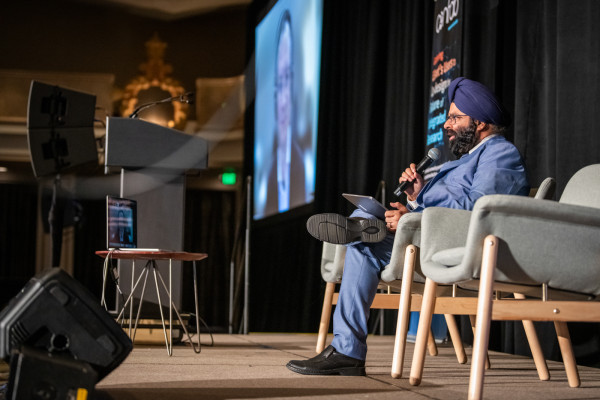
ESnet Executive Director Inder Monga in a remote “fireside chat” with Ben Brown, Director of the DOE Office of Advanced Scientific Computing Research (ASCR) Facilities Division, who participated remotely from Germantown, Maryland.
More than 180 scientists, networking and software engineers, and Department of Energy (DOE) leaders convened in early April in San Francisco and virtually for Confab25, the Energy Sciences Network’s (ESnet’s) largest and most ambitious user meeting to date. Representing 30 organizations, including 12 DOE national laboratories, they came together to share ideas, solve problems, and forge new partnerships to continue to advance the DOE scientific mission.
The third such gathering ESnet has hosted, Confab25 underscored the vital role that high-performance, innovative networking can play in both realizing the DOE’s vision of an Integrated Research Infrastructure (IRI) and unlocking the potential of High Performance Computing (HPC), artificial intelligence and machine learning (AI/ML), and cloud computing to accelerate the next wave of discovery.
“Confab itself represents an experiment in co-design and networking for science,” said ESnet Executive Director Inder Monga. “We are extremely grateful to all of our speakers and attendees for coming together and making this year’s gathering a success.”
From Cutting-Edge Science to Future Visions
Held across the Bay from Lawrence Berkeley National Laboratory (Berkeley Lab), which stewards ESnet, the first three days of Confab25 were packed with keynotes, panels, and lightning talks by more than 40 speakers. (The Confab 25 Program page contains links to most of the presentations.) A fourth day featured breakout meetings for the users of the EJFAT real-time streaming prototype, members of the IRI Management Council, and the ESnet Site Coordinators Committee (ESCC).
The opening session set the tone, with keynotes by Monga and Ben Brown, Director of the DOE Office of Advanced Scientific Computing Research (ASCR) Facilities Division, who participated remotely, followed by a “fireside chat” between the two longtime collaborators. They discussed how the ASCR user facilities, which include ESnet, all must balance the need to provide services that enable scientific discoveries by others with the desire to develop an innovative research infrastructure that can directly accelerate science. They also touched on how the rapid growth of data is driving advancement in AI and HPC resources that demands a new approach to networking—one that is flexible, scalable, and intelligent.
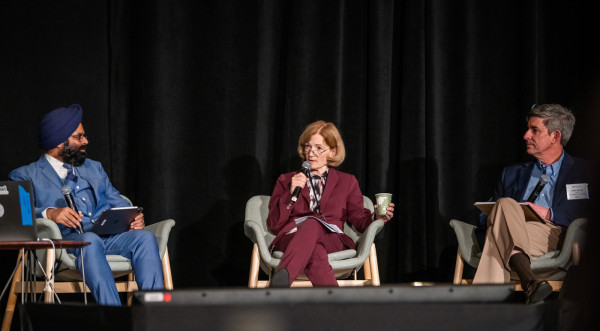
Monga moderated a discussion between Carol Burns, Berkeley Lab’s Deputy Director for Research and Chief Research Officer, and John Sarrao, SLAC National Accelerator Laboratory Director.
That segued into another on-stage conversation, about “Scientific Laboratories of the Future,” between Carol Burns, Berkeley Lab’s Deputy Director for Research and Chief Research Officer, and John Sarrao, SLAC National Accelerator Laboratory Director, moderated by Monga. These two veterans of the national laboratory system agreed that significant change was coming and that partnerships with industry will be essential to meet the demands of tomorrow’s science.
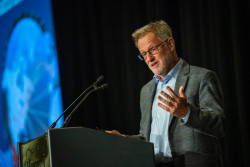
“Harnessing AI where it makes sense can accelerate discovery and open new frontiers in understanding complex phenomena.”
— Ian Foster, Director of Argonne National Laboratory's Data Science and Learning Division
The rest of Day One indicated future directions for DOE-funded scientific research. In his keynote “From Data to Discovery,” Ian Foster, director of the Data Science and Learning Division at Argonne National Laboratory, emphasized how cross-facility collaboration and AI at scale are transforming scientific workflows. “Harnessing AI where it makes sense,” Foster explained, “can accelerate discovery and open new frontiers in understanding complex phenomena.”
Scott Godwin, Director of the Center for Cloud Computing at Pacific Northwest National Laboratory, shared how PNNL has pioneered a hybrid DOE science ecosystem via integration with the commercial cloud. ASCR Advanced Computing Technology Division Director Pavel Lougovski — like Brown, presenting remotely — talked about quantum information science research efforts at ASCR. During the working dinner, William Collins, Associate Laboratory Director of the Berkeley Lab’s Earth and Environmental Sciences Area, discussed how his team was using machine learning and climate emulators to study extreme weather, in the hopes of — among other things — extending scientists’ ability to forecast weather further into the future.
Science-Enabled Networking
Once the big-picture table was set, the program dove into details with carefully curated sessions focused on science and networking themes, including illustrating how ESnet’s role has expanded beyond providing fast data transfer. Today, ESnet enables complex scientific workflows, supports large-scale experiments, and fosters seamless collaboration across facilities.
For example, as Adam Bolton and Julio Ibarra shared in a one-two combo of science and networking presentations, the Vera C. Rubin Observatory’s new Legacy Survey of Space and Time (LSST) will need to transmit massive data sets continually, all night and every night. The data must be transferred from Chile fast enough to the U.S. Data Facility (USDF) at SLAC National Accelerator Laboratory in California for the data to be analyzed and alert researchers of any interesting developments in the night sky so that other telescopes in Chile and elsewhere can be repositioned to focus on them. The camera will take a picture of the southern sky approximately every 30 seconds, and produce a 13 gigabyte image. Each image must be transferred to the USDF within 7 seconds, inside the 30-second observation cadence. It will be able to do so because of the Rubin Observatory Long Haul Network (LHN), a collaboration of South American and U.S. national research & education networks (NRENs) that includes ESnet.
In addition to speakers from the many organizations with which ESnet collaborates, ESnet staff also shared updates on successful codesign partnerships such as EJFAT as well as innovative service offerings such as ESnet’s OSCARS on-demand registration service, cloud services, measurement & analytics, High Touch network telemetry, and more.
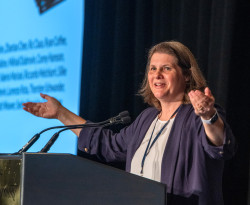
“Confab is where 'innovaction' takes center stage....Confab sparks the kind of progress that is rewriting the playbook for big-data science.”
— Jana Thayer, Division Director at SLAC’s Linac Coherent Light Source
The Confab Call to “Innovaction”
In her Day 2 keynote, “Love in the Time of Exascale: Orchestrating a Future-Proof Romance Between LCLS-II, AI, and DOE’s HPC Ecosystem,” Jana Thayer, Division Director at SLAC’s Linac Coherent Light Source, accidentally coined the word “innovaction”—a portmanteau of innovation and action — and others subsequently began to invoke it to describe what DOE science needs now.
Afterward, Thayer described Confab as “where innovaction takes center stage. It’s where DOE’s scientific computing, networking, and research innovators come together to co-design the next generation of integrated research infrastructures. Facilitated and enabled by ESnet, Confab sparks the kind of progress that is rewriting the playbook for big-data science.”
IRI was once again a major theme for Confab, with updates from the IRI Management Council showcasing the efforts under way to unify research resources across DOE’s laboratories. The goal: create a seamless, flexible infrastructure capable of supporting diverse scientific workflows—from fusion experiments at General Atomics’s DIII-D facility to sharing and analyzing data from the JGI Analysis Workflow Service, or JAWS.
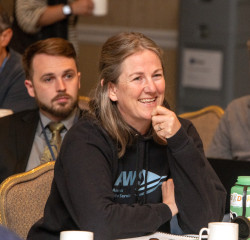
“There's nothing quite like focused time away from work/meetings/ distractions to problem-solve together.”
— Kjiersten Fagnan, Chief Informatics Officer of the Joint Genome Institute
Attendees appreciated the opportunity to meet face to face. “I make a point to attend ESnet's Confab25 because it is a space where folks from across DOE computing resources (ASCR and others) can get together for in-person discussions. There's nothing quite like focused time away from work/meetings/distractions to problem-solve together,” said Kjiersten Fagnan, Chief Informatics Officer of the Joint Genome Institute. “It was terrific to be able to sit down with folks from other labs to address some data challenges we'd been blocked on for a while.”
Throughout the event, speakers emphasized that the future of scientific discovery depends on seamless collaborations. Integrating workflows across the labs, instruments, and HPC facilities, harnessing AI where it makes sense, and exploring quantum technologies will all be part of the broader strategy to build an adaptable, resilient research infrastructure — one for which ESnet’s role as a connector, collaborator, and innovator remains critical.
Don’t miss Confab26, scheduled for April 26–May 2, 2026. Program and location information will be shared closer to the date at www.es.net/confab. (Subscribe to be added to the Confab mailing list. For questions, contact User-Outreach@es.net.)



